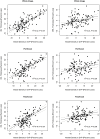Quantitative assessment of retinal thickness and vessel density using optical coherence tomography angiography in patients with Alzheimer's disease and glaucoma
- PMID: 33739997
- PMCID: PMC7978346
- DOI: 10.1371/journal.pone.0248284
Quantitative assessment of retinal thickness and vessel density using optical coherence tomography angiography in patients with Alzheimer's disease and glaucoma
Abstract
Purpose: Assessment and a direct comparison of retinal vessel density with the thickness of inner retinal layer (IRL) and outer retinal layer (ORL) in the same regions of the macula in subjects with Alzheimer's disease (AD) and primary open-angle glaucoma (POAG).
Methods: We analyzed data from 48 eyes of healthy control (HC) participants, 71 eyes with POAG, and 49 eyes of AD patients. Ophthalmic examination included optical coherence tomography (OCT) imaging to measure IRL and ORL thickness and OCT angiography (OCTA) in the same region for the imaging of vessel density in the superficial vascular plexus (SVP) and deep vascular plexus (DVP) of the retina. A direct comparison of vessel density and retinal layers thickness, which different dynamic ranges, was obtained by normalizing values as percentage losses.
Results: Patients with AD presented significantly greater losses of vascular density in the DVP and ORL thickness compared to POAG (p <0.001), but percentage losses of vessel density in SVP and IRL thickness were considerable in POAG compared to AD eyes (p<0.001). Positive associations among presence of AD were observed primarily in outer retina where a 1% decrease of ORL thickness was associated with about 24-29% increase in odds of the presence of AD. According to OCTA measurements, a 1% decrease of vessel density in DVP was positively associated with a 4-9% increase in odds of the presence of AD. In POAG positive associations among presence of disease were observed only in inner retina where 1% loss of IRL thickness and a 1% loss of vessel density in the SVP were positively associated with a 13-23% increase in risk of presence of the disease.
Conclusions: Analysis of ORL thickness and vessel density in DVP could potentially improve diagnostic capabilities and may provide a valuable approach for predicting of AD.
Conflict of interest statement
The authors have read the journal’s policy and have the following competing interest: RK is a paid employee of Sue Ryder Home leading by Pallmed Ltd (https://www.sueryder.org/). There are no patents, products in development or marketed products associated with this research to declare. This does not alter our adherence to PLOS ONE policies on sharing data and materials.
Figures


Similar articles
-
Comparison of Retinal Microvasculature in Patients With Alzheimer's Disease and Primary Open-Angle Glaucoma by Optical Coherence Tomography Angiography.Invest Ophthalmol Vis Sci. 2019 Aug 1;60(10):3447-3455. doi: 10.1167/iovs.19-27028. Invest Ophthalmol Vis Sci. 2019. PMID: 31408108
-
Macula Vessel Density and Thickness in Early Primary Open-Angle Glaucoma.Am J Ophthalmol. 2019 Mar;199:120-132. doi: 10.1016/j.ajo.2018.11.012. Epub 2018 Nov 26. Am J Ophthalmol. 2019. PMID: 30496723 Free PMC article.
-
Quantitative Analysis of Microvasculature in Macular and Peripapillary Regions in Early Primary Open-Angle Glaucoma.Curr Eye Res. 2020 May;45(5):629-635. doi: 10.1080/02713683.2019.1676912. Epub 2019 Oct 14. Curr Eye Res. 2020. PMID: 31587582
-
Vascular biomarkers from optical coherence tomography angiography and glaucoma: where do we stand in 2021?Acta Ophthalmol. 2022 Mar;100(2):e377-e385. doi: 10.1111/aos.14982. Epub 2021 Aug 6. Acta Ophthalmol. 2022. PMID: 34363322 Free PMC article. Review.
-
Retinal imaging and Alzheimer's disease: a future powered by Artificial Intelligence.Graefes Arch Clin Exp Ophthalmol. 2024 Aug;262(8):2389-2401. doi: 10.1007/s00417-024-06394-0. Epub 2024 Feb 15. Graefes Arch Clin Exp Ophthalmol. 2024. PMID: 38358524 Review.
Cited by
-
Alterations of Macular Structure in Non-Glaucomatous Subjects With Obstructive Pulmonary Function.Invest Ophthalmol Vis Sci. 2023 Aug 1;64(11):24. doi: 10.1167/iovs.64.11.24. Invest Ophthalmol Vis Sci. 2023. PMID: 37589982 Free PMC article.
-
Evaluation of macular microvascular density using optical coherence tomography angiography in patients with Posner-Schlossman syndrome.BMC Ophthalmol. 2022 Aug 10;22(1):339. doi: 10.1186/s12886-022-02563-z. BMC Ophthalmol. 2022. PMID: 35948955 Free PMC article.
-
Assessment of individual retinal layer thickness and vascular changes in Alzheimer's disease.Sci Rep. 2025 May 19;15(1):17287. doi: 10.1038/s41598-025-02377-1. Sci Rep. 2025. PMID: 40389598 Free PMC article.
-
Optical coherence tomography angiography analysis methods: a systematic review and meta-analysis.Sci Rep. 2024 Apr 26;14(1):9643. doi: 10.1038/s41598-024-54306-3. Sci Rep. 2024. PMID: 38670997 Free PMC article.
-
Retinal Dysfunction in Alzheimer's Disease and Implications for Biomarkers.Biomolecules. 2021 Aug 16;11(8):1215. doi: 10.3390/biom11081215. Biomolecules. 2021. PMID: 34439882 Free PMC article. Review.
References
Publication types
MeSH terms
LinkOut - more resources
Full Text Sources
Other Literature Sources
Medical

